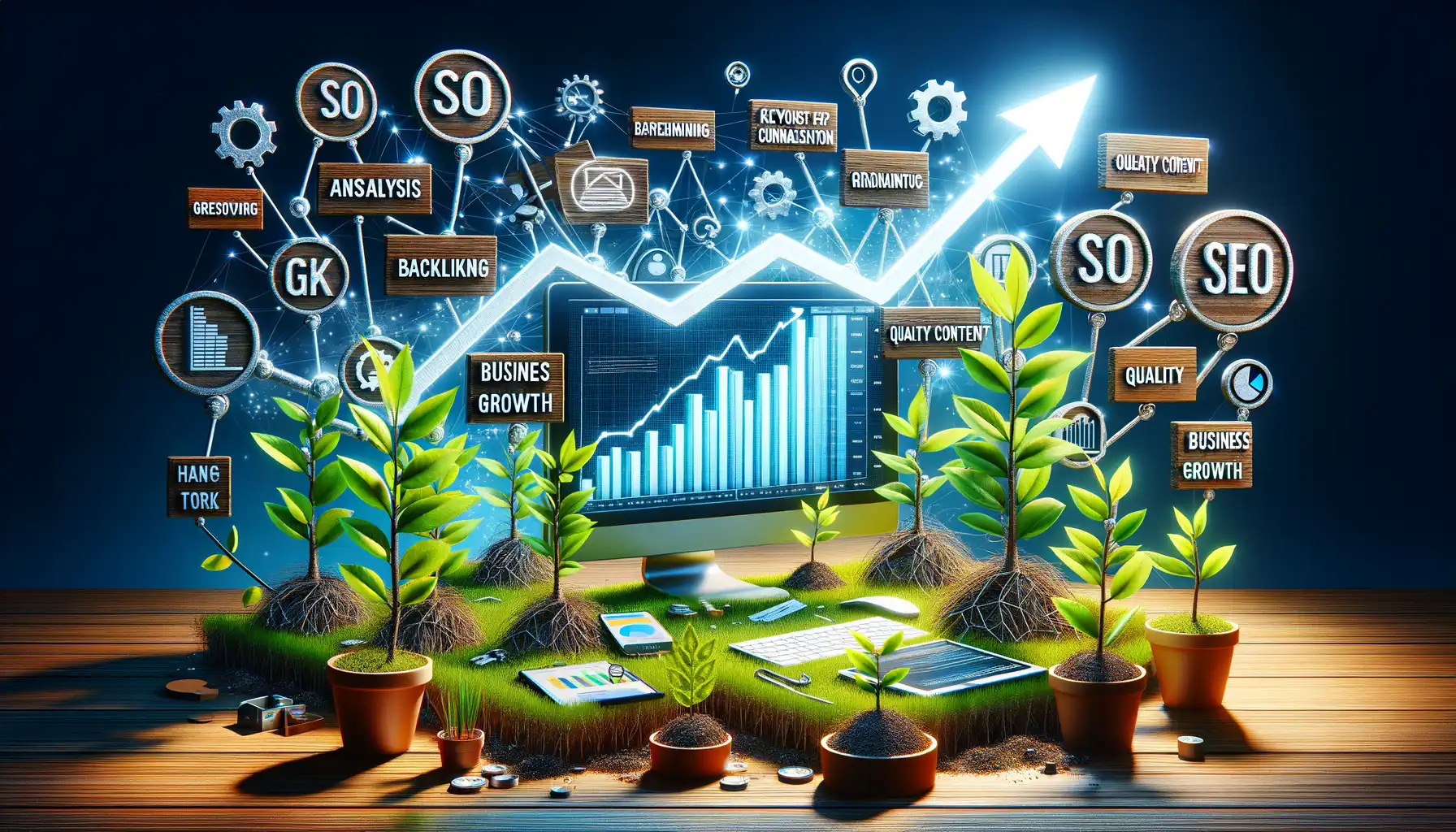Understanding the Fundamentals of SEO
Why SEO Is the Foundation of All Things Digital
Picture your website as a stunning, modern shop sitting in the middle of a deserted street. No matter how incredible it looks or how much effort you’ve put into decorating its digital shelves, if no one knows it exists, it stays empty. Enter Search Engine Optimization (SEO), your map and megaphone to guide people straight to your door.
At its core, SEO is all about making your website irresistible—not just to visitors, but to search engines like Google or Bing. Think of search engines as matchmakers; they want to pair users’ questions (or queries) with the best possible answers. To win their love, you’ve got to show them you’re the perfect fit!
The Building Blocks of SEO Magic
So, how does one catch the eye of these digital matchmakers? It starts with understanding these core building blocks:
- Keywords: These are the phrases people type when searching online. Targeting the right ones is like speaking your customer’s language.
- Content: Blogs, guides, videos—anything useful that answers questions—and yes, more is better!
- Technical optimization: Speed, mobile-friendliness, clean URLs. Think of this as tidying up your “shop.”
When these fundamentals come together, your website becomes a place search engines adore recommending—and visitors keep coming back for more.
How SEO Contributes to Business Growth

Fueling Your Business Engine with SEO
Picture this: Your business is a dazzling storefront on the busiest street in town. But here’s the catch—there’s no sign, no advertising, no way for people to discover you. That’s what your website is like without Search Engine Optimization (SEO). It’s there, but invisible.
SEO turns your online presence into a magnet, pulling the right customers directly to you. Imagine ranking high on Google—it’s like planting your store in the center of Times Square. This visibility translates into more clicks, more leads, and yes, more sales. Businesses that invest in SEO often see their organic traffic soaring by as much as 40%-50%, and that’s not just numbers; it’s real people finding real solutions through you.
The Ripple Effect of SEO’s Impact
Once SEO goes to work, its benefits spread like ripples in water. Here’s how:
- Brand Authority: A high-ranking website builds trust and credibility.
- Cost-Effective Marketing: Unlike ads, SEO works 24/7 without adding costs.
- Better User Experience: Faster page loads and relevant content keep visitors hooked.
Every time someone searches and finds you, it’s the equivalent of word-of-mouth in the digital age. Now, isn’t that the kind of growth you’d want?
Key Elements of an Effective SEO Strategy

Building Blocks for SEO Success
Your SEO strategy isn’t some dusty old checklist—it’s the lifeblood of your online presence. To truly captivate search engines and, more importantly, your audience, you need to nail down several crucial elements. Think of it as crafting a masterpiece where every brushstroke counts.
- Keyword Research: Imagine you’re trying to speak your customer’s language. What are they typing into that search bar at 2 a.m.? Tools like Google Keyword Planner or Ahrefs can uncover those golden queries.
- Content Creation: It’s not just about words; it’s about stories, solutions, and value. Are you answering a burning question? Solving a problem? Make content that resonates, whether it’s a heartfelt blog post or a viral video tutorial.
- On-Page Optimization: The unsung hero in SEO! From compelling meta descriptions to well-organized headers, these tweaks act as breadcrumbs guiding search engines straight to your pages.
The Magic of Off-Page Strategies & Analytics
Now let’s step beyond your website’s borders. Think about quality backlinks; they’re like enthusiastic endorsements from other sites saying, “Trust me, this page rocks!” Want a real-world tip? Forge relationships with industry leaders or guest post on high-authority platforms.
Finally, don’t ignore analytics. Tools like Google Analytics or SEMrush offer an open window into what’s working. Your SEO strategy should evolve based on hard numbers—whether it’s a jump in organic traffic or a sudden dip that needs fixing fast.
Common SEO Mistakes to Avoid

Are You Falling Into These Common SEO Traps?
Let’s get real for a second—SEO isn’t some mystical art, but boy, can it feel that way when simple mistakes trip you up. Picture this: you’ve poured your heart into crafting your website, but it’s stuck on page 10 of search results. Ouch! Chances are, one of these common blunders is to blame:
- Keyword Stuffing: Using the same keyword over and over? Google sees right through that. Instead, focus on natural, meaningful content.
- Ignoring Mobile Optimization: Your site might look stunning on desktop, only to fail miserably on a smartphone. Considering mobile users dominate the web now, this is a deal-breaker.
- Skipping Alt Text: Fancy graphics without descriptive alt text are invisible to search engines. That’s like shouting into a void instead of having a real conversation!
The Overlooked Mistakes Businesses Keep Making
Ever forgotten to keep your site up-to-date? It happens, but broken links and outdated content send the message: “I don’t care about my users.” Equally frustrating? Not taking time to analyze your data. Those analytics dashboards aren’t just pretty—they’re treasure troves of insights. Invest the time to understand what’s working and where you’re losing ground.
And here’s one more: brushing off local SEO. If you’re running a cozy bakery in Chicago, wouldn’t you want *people in Chicago* finding you first? Local keywords matter!
Future Trends in SEO for Online Businesses

The Rise of AI-Driven Search
Picture this: search engines are getting smarter, almost eerily so. With the explosive evolution of AI-powered algorithms, traditional keyword-stuffing strategies are dying a slow death. Instead, search engines like Google are diving deep into context and user intent. Think about it—when someone types “best laptop for students,” they don’t want a random product list; they’re seeking tailored recommendations that *make sense for their needs*.
For online businesses, this means crafting content that feels like a thoughtful conversation rather than robotic repetition. Incorporating tools like natural language generation (NLG) can help you stay ahead—platforms like Jasper and Frase are your new friends here! Meanwhile, don’t forget about voice search optimization. AI-powered assistants like Alexa and Siri are making people adopt more conversational queries. Is your website ready to chat back?
- Shift from generic keywords to long-tail, intent-based phrases.
- Focus on answering specific questions your audience might ask aloud.
Visual Search & Multimodal Content
Here’s where things get even cooler—and visual. Platforms like Pinterest and Google Lens have shown that visual search is no longer a futuristic idea; it’s now part of how users shop, research, and discover. Imagine snapping a photo of a sleek pair of boots, and boom—you’re flooded with options to buy similar ones. If you’re in eCommerce, optimizing for image search could be your ticket to standing out.
Another trend to watch? Blending multimodal content. Users increasingly crave a mix of text, visuals, videos, and even interactive features. For example, blogs that include snippets of video tutorials or immersive infographics not only capture attention but also keep users engaged longer. And longer engagement? That rings all the right SEO bells.
Adapt now, because tomorrow’s audience doesn’t just browse—they immerse, compare, and choose brands that truly “get” them. Will yours be one of them?



